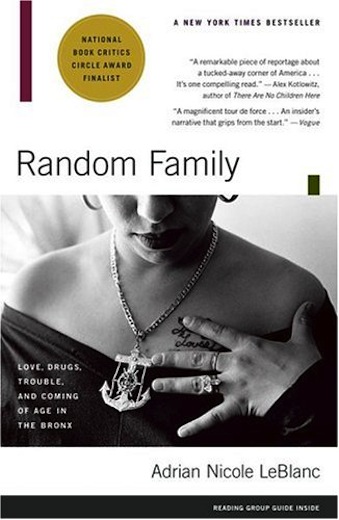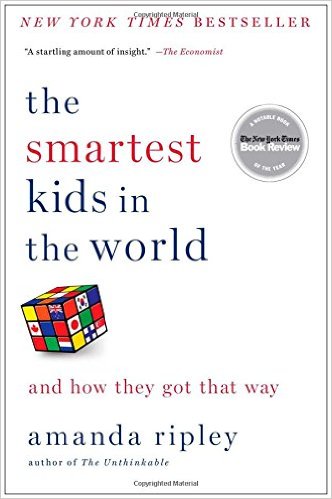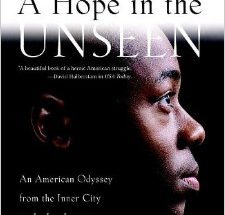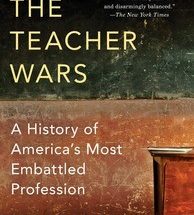In one scene in Adrian Nicole LeBlanc’s Random Family, Jessica decides to get a tattoo on her chest that reads, “Jessica Loves George.” George—known to those in his Bronx community as Boy George—is a notoriously violent heroin dealer who is serving a life sentence in federal penitentiary. Jessica, despite George’s perpetual abuse and life sentence, is desperate to prove to him that her love is sincere. LeBlanc explains that George will be in jail until the tiny seeding in Central Park will be a tree, and that Jessica remains anxious to convey her love despite George’s obvious predicament.
LeBlanc writes: “It was as if Jessica was trying to convince herself of love from the outside in.”
Random Family is about love, and the damaging effects of growing up in an environment in which love is absent. Published in 2003, the story follows one, very extended family living in the Tremont area of the Bronx in the 1990s. The book centers on themes of poverty, drug addiction, pervasive sexism and gender roles, sex, ignored trauma, ambition, and violence.
In 1998, LeBlanc met the two female primary characters, Jessica and Coco, during Boy George’s trial. LeBlanc became interested in the lives of Jessica and her brother, Cesar (Coco was Cesar’s girlfriend). Although the book centers on Jessica, Coco, and Cesar, a plethora of characters are present: Lourdes, Jessica and Cesar’s mother, and her numerous boyfriends; Milagros, who is friends with Pepe, the father of Jessica’s first-born; and Serena and Mercedes, two of Jessica and Coco’s eventual ten children.
The book is told in four parts, largely centered on prison time: The Street, Lockdown, Upstate, and Breaking Out. The characters must maintain relationships (or the semblance of relationships) amid cocaine, crack, heroine, and an extremely profitable drug industry. The book reminded me of the urban novels written by Sister Souljah. LeBlanc’s vivid detail and reconstruction paint an accurate picture of Tremont, where—according to The Bronx Data Center—over half the population lives below the poverty line and receives public assistance (AFDC, Home Relief, Supplemental Security Income, and Medicaid).
Two specific aspects of the book particularly intrigued me. First, several of the female characters have signs of sexual trauma or STDs by the time they are five. When the adults are confronted with these horrifying facts, many resort to a defensive game of pointing fingers. LeBlanc suggests that the children are lost in the arguing, largely because the adults still have profound psychological trauma from their childhoods. Second, there is hardly any mention of school. At one point, Child Protective Services comes because Coco’s children have accrued so many absences. Serena writes a letter about wanting to be a teacher, but her writing is poor. The children move from house to house to such an extent that it is highly unlikely they will ever receive an education in a stable environment.
LeBlanc immersed herself in the lives of her characters for 11 years, often sacrificing her emotional wellbeing while forming intense, personal relationships. In an interview that she gave The New Yorker in 2013, LeBlanc discussed her relationship with Coco, one of the primary characters:
“There were days when I forgot that I was reporting (always a sure sign of good work!), and I remember one specifically: Coco had gone to the E.R. with her brother, and one of the children asked me for paper from my notebook. I was the go-to source for paper and pens, and the children liked to draw. Only when she asked me for my reporter’s pad did I realize that I’d become so consumed by the day—overwhelmed by it—that I’d forgotten to take out my notebook. The scary night in question in this passage was terrifying for all of us. Both Coco and I were glad for one another’s presence. We love each other. I think—and this is true for many single parents with small children—that it’s always helpful to have another adult around. Danger was always mitigated by companionship.”
Critical reception of the book varied. Some people advocated strongly of the importance of reading an extended narrative as heartfelt and thorough as LeBlanc’s. Others, however, insisted the only people who should read the book are politicians, who have a certain power to help change the situations of the individual characters. If a layperson were to read this book, some said, it would be exploitive of the characters LeBlanc chose to follow. I disagree—Random Family provides the reader the opportunity to not view Jessica and Coco’s experiences as insular, but rather as truthful examples of the lives of millions living in poverty in this country.
In the same The New Yorker interview, LeBlanc explains what she believes is the primary theme of her book: “I do believe the book documents a certain moment of the destruction created by the war on drugs—the beginning of the devastating impact mass incarceration has on families living in poverty. History will judge us harshly on the racism and willful passivity involved.”




